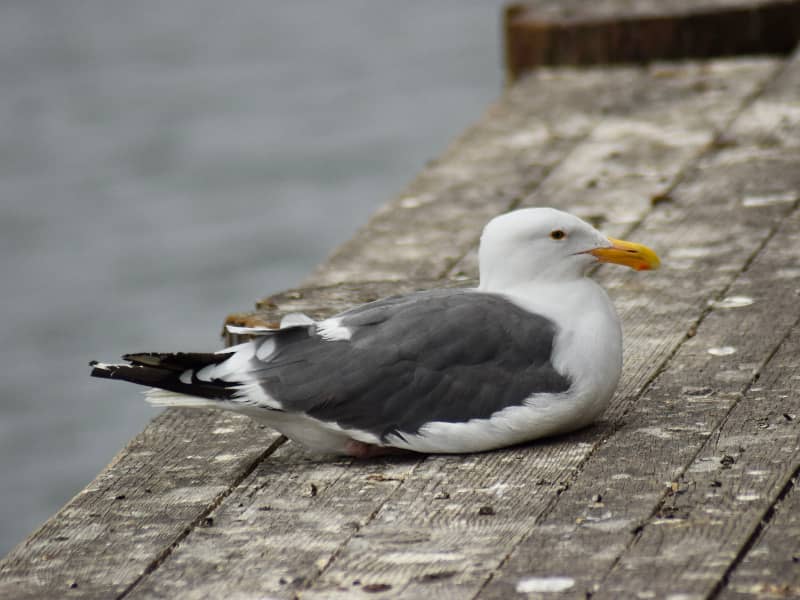
Caspian Gull
Are you looking for interesting facts about the Caspian Gull? Then you've come to the right place! In this article you will learn everything you need to know about this fascinating coastal bird species. We'll introduce you to the gull, describe its appearance and habitat, as well as its behavior. So sit back and dive into the world of the Steppe Gull.
Description of the Steppe Gull
Appearance
The Steppe Gull is a medium-sized gull species that grows to about 40 cm. Their plumage is predominantly white, with gray on the upper side of their wings. Their bright red legs and bold yellow bill are particularly striking. Young Steppe Gulls are grayish brown in color and have a dark bill. In winter plumage, the Caspian Gull resembles other gull species found at the sea.
Habitat
The Steppe Gull is widespread in Europe, Asia and North America. Their habitat is coastal areas, islands and estuaries. They can also sometimes be found in inland waters, such as lakes and rivers. The Caspian Gull is adaptable and is also found in urban areas.
Behavior
The Caspian Gull feeds on fish, crustaceans, mollusks and other marine life. It breeds in colonies on the ground, sometimes on building roofs or rocks. The breeding season lasts from April to June. During the breeding season, the parent gulls defend their nest fiercely against intruders. In the fall, the Caspian Gull migrates to warmer regions and spends the winter on the coast.
Ecological role
The Caspian Gull is an important part of the marine ecosystem. As an opportunistic species, it adapts to the conditions of its habitat and thus influences food webs. The Caspian Gull also plays an important role in the dispersal of seeds from plants, which they eat and excrete undigested.
Steppe gull conservation: successes and challenges
Have you ever wondered how the Caspian Gull is protected? In this section we would like to show you the threats to the Caspian Gull and what protective measures are being taken. We will show you what successes have already been achieved and what challenges still need to be overcome.
Threat and protection
Threat
The Steppe Gull is threatened due to habitat loss, pollution and hunting. Habitat destruction, especially wetlands, is shrinking the gull's habitat. In addition, many coastal areas suffer from pollution, which negatively affects the food sources of the Caspian Gull. In some regions, the Caspian Gull is also hunted, as it is seen as competition by fishermen.
Protective measures
Various protective measures have been taken to protect the gull. In some countries, there are legal protection regulations for the Steppe Gull. In addition, protected areas are established to protect the habitats of this gull. Research is also being conducted in many areas to better understand the lifestyle of the Caspian Gull and to take specific conservation measures.
Success and challenges
Successes in conservation work for the Caspian Gull
Success has already been achieved through the protection measures. In some areas, the population of the Steppe Gull has been stabilized. In other regions, the gull has even reappeared after previously becoming extinct there. These successes show that targeted conservation measures can work.
Challenges and obstacles
Despite the successes, there are still challenges and obstacles to conservation work. One of the biggest challenges is the cooperation between different stakeholders, such as fishermen and conservation organizations. Conflicts over the use of marine resources can become an obstacle to gull conservation. Funding for conservation efforts is also often a challenge, as resources are limited.
Caspian Gull Conclusion
The Caspian Gull is an endangered species, which can, however, be saved by targeted protection measures. Successes have already been achieved through legal protection regulations, protected areas and research projects. However, there are still challenges and obstacles that need to be overcome in order to sustainably protect this gull. We can all contribute to this by working hard to protect the Steppe Gull.
Author

-
Garden animal - A life with nature
Welcome to my animal blog! My name is Dirk and I am happy to take you on my journey through the fascinating world of animals and gardening.
Born 54 years ago, I have had an insatiable curiosity for the animal world around me since childhood. Although I have moved professionally in other industries, my true passion has always been animals and nature. It is remarkable how a small garden has become such an important part of my life.
Many of my fondest memories are associated with the animals that share our home. Whether it's the curious squirrels that scurry across the trees in the morning, the colorful variety of birds that visit our feeders, or the busy bees and butterflies that pollinate our flowers, every moment with them is invaluable to me.
This blog is my contribution to share my experiences, discoveries and insights with like-minded people. Here I will share stories of unforgettable encounters with animals, give tips on gardening and creating wildlife-friendly habitats, and take you on my journeys through nature.
Thank you so much for being here!
Cordial,
Dirk aka garden animal
Last posts
- 27. February 2024PetsVeganes Hundefutter – Grün und Gesund?
- 18. January 2024ChickensOregano für Hühner
- November 27, 2023HamsterDiurnal hamsters
- November 24, 2023HamsterHamster hammock
